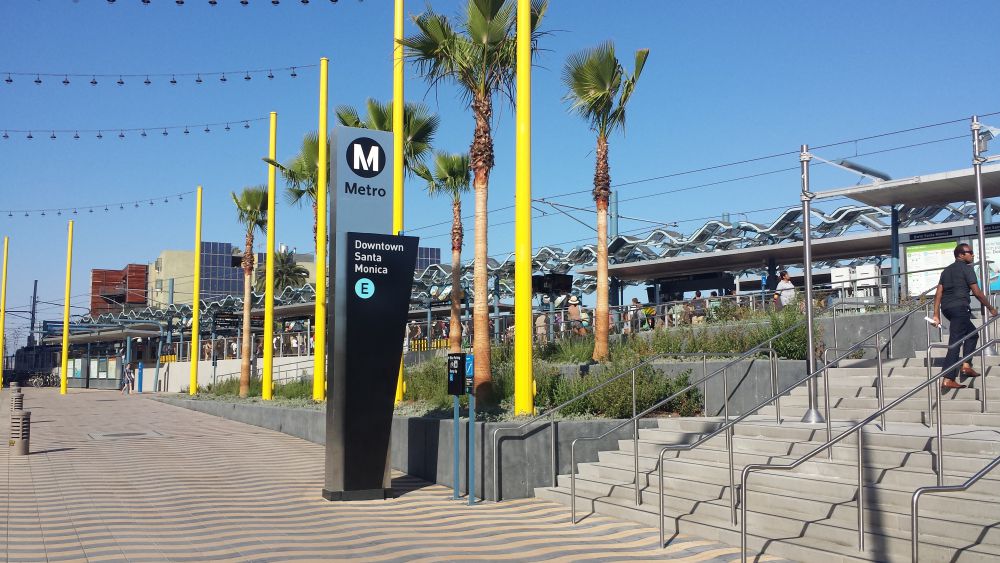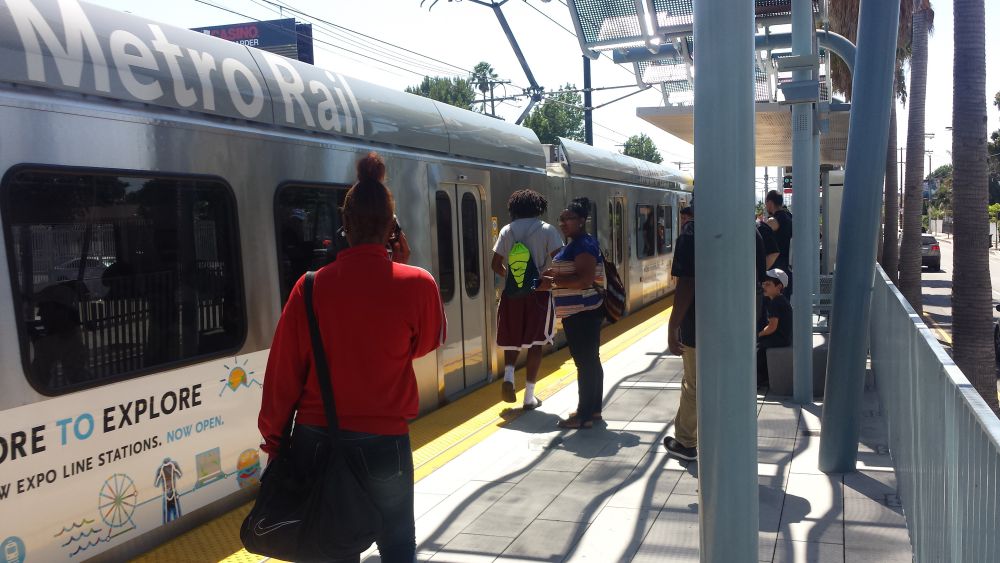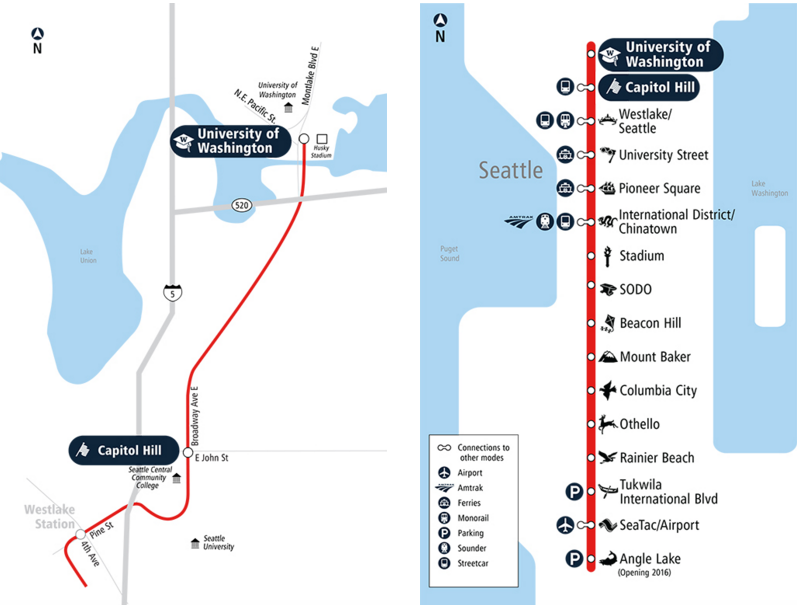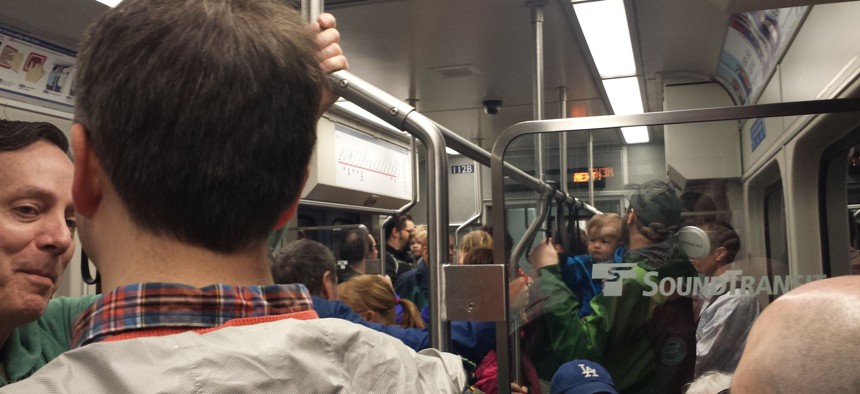Connecting state and local government leaders
Commuters have rushed to embrace new extensions for L.A. Metro’s Expo Line to Santa Monica and Link light rail in Seattle. But where will all those new West Coast straphangers fit?
SANTA MONICA, Calif. — It seems like a fairly simple concept when it comes to new public transportation investments: If you build high-quality and reliable transit that brings people where they want to go and can take them there relatively quickly, they will ride it.
I found that to be clearly the case while riding Los Angeles Metro’s recently opened Expo Line light-rail extension to and from Santa Monica during a recent visit. It was packed with riders in a region that is notoriously wedded to single-occupancy vehicles and congested freeways. But L.A.’s transit landscape is undergoing dramatic change, with major light rail and Metro Rail subway extensions underway, along with a downtown light-rail tunnel that will eventually stitch the growing regional network together.
That regional rail network now reaches Santa Monica with its famous pier and beaches. The city of around 92,000 residents is a top tourist destination and a job center, part of L.A.’s Silicon Beach tech hub. It's a natural transit destination.

As I discovered during my excursion, there were plenty of beachgoers on the Expo Line but there were also many folks in office attire who appeared to be reverse commuting. During my rides to and from Santa Monica and the Expo / Vermont Station in L.A., the rail cars I rode in were packed like sardines, reminiscent of some New York City subway lines during peak travel periods.

Ridership on the Expo Line, not unexpectedly, has increased since the Phase 2 extension between Culver City and Santa Monica opened in May. It jumped from an average of 30,000 weekday passengers before the extension opened to an average of more than 45,000 weekday passengers after. As the Los Angeles Times reported this past weekend, the Expo Line is experiencing major crowding conditions because the agency is dealing with a shortage of rail cars due to years of delays from contracting, delivery and testing of new rolling stock.
Among the challenges a transit agency can face, not having enough rail cars to meet growing ridership demands is a good problem to have—though until that need is met, it’s not so great for passengers, especially those in wheelchairs who can’t squeeze into crowded rail cars.
There’s a somewhat similar story playing out about 1,000 miles to the north in Seattle. This spring, just like with the Expo Line, Sound Transit, which runs the Seattle-area’s growing Link light-rail system, opened up what has quickly become a very popular two-station extension.
From the Downtown Seattle Transit Tunnel, Link passengers can now quickly reach the University of Washington and the Capitol Hill neighborhood via the ULink light-rail subway, which is currently being extended northward (a 4.3-mile section with three new stations by 2021 and, by 2023, 8.5 miles of additional track with four new stations) as part of previously approved Sound Transit network expansions.

But just with the new two-station, 3.15-mile light-rail subway extension to the University of Washington, Link ridership has soared since it opened in March.
According to Sound Transit, ridership for May 2016 jumped 83 percent over May 2015, with around 65,000 weekday passengers, a figure that’s held for June, too.
The reason for the dramatic jump is pretty simple: Link now connects one of the densest neighborhoods north of San Francisco (Capitol Hill) and one of Seattle’s largest employers and activity centers (the University of Washington) with the Puget Sound region’s largest and densest commercial business district.
In July, Seattle Times columnist Danny Westneat explored the reasons why the Link light-rail system has suddenly become so popular, especially in a city that resisted rail transit investment for decades:
The transportation planning answer is that Capitol Hill and UW were considered the two most desirable mass-transit markets in the nation that weren’t already served by subway or rail. So putting train stops there was a no-brainer. (This makes it even more of a head-banger that it took us so long to do it!)
It’s indeed a head-banger and a no-brainer, especially for an area whose voters infamously gave the thumbs down to transit plans in 1968 and 1970 that prompted the federal government to fund the construction of Atlanta’s MARTA rail network instead.
Fast forward to 2016 and ULink’s opening has very much been transformative for mobility in one of the densest areas of Seattle, with trips to and from Capitol Hill and the university now only taking a few minutes. (Previously, under the worst traffic conditions, some bus trips between the university and downtown could take upwards of 45 minutes.)
And just like with the Expo Line, Sound Transit, in the midst of its successful expansion, is dealing with some capacity issues. During peak times, the agency is facing crowded conditions and doesn’t have an overabundance of spare vehicles at the moment to lengthen its two-car train sets to three-car train sets systemwide. The agency contends it has enough rail cars to deal with current ridership demands, as The Seattle Times recently reported, but has also introduced a select number of three-car trains to help ease the crowded conditions.
As someone who rides Link regularly, I can attest that the “crowded” rail cars don’t stack up to the “crush loads” many New York City straphangers experience on many subway lines. Still, Seattle’s recent enthusiasm for its maturing light-rail network sets the system up well for the future. (More train cars to be built by Siemens are on the way, too. Eventually.)
Forthcoming extensions of the Link system that are under construction or have been approved promise to send ridership numbers skyward in the years to come. And the successful opening of ULink gives Sound Transit a great story to promote as the agency seeks voter approval for an even larger transit package on the November ballot.
There are few cities and regions currently undertaking such ambitious transit expansions.
As Zach Shaner of Seattle Transit Blog wrote in June, what the Seattle area is building with Link compared to other U.S. cities stands out (emphasis his).
We are choosing to do the hardest possible thing, to build new, grade separated, truly high capacity transit. We’re doing so in a wealthy region, through and under valuable land, while appeasing every environmental regulation, mitigating every property owner’s complaint, showering goodies at cities along the way, and securing the majority support of a very engaged citizenry.
The legacy systems of New York and Chicago, etc, built hard things the easy way, with often callous disregard for human life and the environment. Today our peer cities are building easy things the hard way, creating inferior products while encumbered in the same process mess. We are choosing to build hard things the hard way. That is by definition torturous, but it’s also the only way to get real value out of what we’re paying for.
While grand transit visions taking shape in Los Angeles and Seattle aren’t necessarily scalable for all communities, there are some key takeaways pretty fundamental when it comes to transportation planning, regardless of locale: When you build reliable and high-quality transit to places that people want to go and bring them from Point A to point B quickly and efficiently, people will ride it.
And there’s no denying that transit audiences are embracing the Expo Line and ULink in their respective cities. But there are good reasons for that, reasons that are pretty simple.
Michael Grass is Executive Editor of Government Executive’s Route Fifty and the founding co-editor of DCist. He previously wrote about D.C.-area transit and local news for The Washington Post’s Express, Washington City Paper and The Huffington Post. In 2002, he worked as a communications consultant on a post-9/11 Federal Transit Administration emergency management program bringing together transit agencies with their first responder communities and intergovernmental stakeholders. He is based in Seattle.

NEXT STORY: For records preservation, Arkansas turns to the cloud




